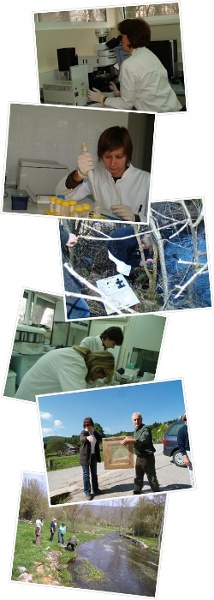 Laboratorij za ihtiopatologiju-biološke materijale osnovan je krajem 2002. godine u Zavodu za kemiju materijala Instituta "Ruđer Bošković" kao Grupa za ihtiopatologiju-biološke materijale. Laboratorij čine četiri veterinara-ihtiopatologa sa dugogodišnjim iskustvom u struci i jedan molekularni biolog, a njihove se specijalizacije i istraživački interesi međusobno nadopunjuju. Predmet istraživanja članova Laboratorija su ribe, rakovi i školjke.
Laboratorij za ihtiopatologiju-biološke materijale osnovan je krajem 2002. godine u Zavodu za kemiju materijala Instituta "Ruđer Bošković" kao Grupa za ihtiopatologiju-biološke materijale. Laboratorij čine četiri veterinara-ihtiopatologa sa dugogodišnjim iskustvom u struci i jedan molekularni biolog, a njihove se specijalizacije i istraživački interesi međusobno nadopunjuju. Predmet istraživanja članova Laboratorija su ribe, rakovi i školjke.
Primarni interes Laboratorija obuhvaća istraživanja biokemijskih parametara krvi riba, te određivanje standardnih, referentnih vrijednosti uzgajanih i slobodnoživućih vrsta riba. Naši trenutni napori usmjereni su na revitalizaciju ugrožene populacije potočne pastrve i potočnog raka u krškim rijekama. Provodimo makroskopske i mikroskopske analize histoloških preparata različitih tkiva u raznim životnim ciklusima brojnih vrsta akvatičnih životinja, te procjenu nametničke populacije. Znanstveni interes Laboratorija su istraživanja iz područja patologije riba, biokemije krvi, pato/histologije, genetike riba, učinka i primjene antibiotika, procjene i kreiranja brzih testova za određivanje bakterijskih patogena.
Misija je Laboratorija postati prepoznatljivom kroz znanstvena istraživanja na području ihtiohematologije i molekularne ihtiologije, te ihtiopatologije.
Jakost Laboratorija je u dugogodišnjem znanstvenom i stručnom iskustvu, suradnji sa stručnjacima i izvan IRB-a, mogućoj primjeni znanja i usmjeravanja istraživanja prema zahtjevima tržišta farmaceutske, prehrambene industrije i zaštite ljudskog zdravlja
 Dana 29.6.2006. održana je osnivačka skupština za «Hrvatski centar za autohtone vrste riba i rakova krških voda» u Otočcu kojemu je IRB-Laboratorij za ihtiopatologiju-biološke materijale suosnivač. Link na Centar: http://www.pastrveituristi.otocac.hr/
Dana 29.6.2006. održana je osnivačka skupština za «Hrvatski centar za autohtone vrste riba i rakova krških voda» u Otočcu kojemu je IRB-Laboratorij za ihtiopatologiju-biološke materijale suosnivač. Link na Centar: http://www.pastrveituristi.otocac.hr/

 Site in english
Site in english